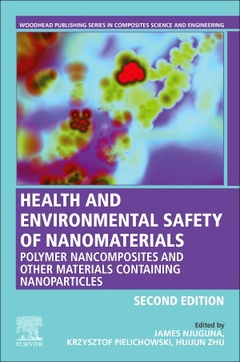Description
Health and Environmental Safety of Nanomaterials (2nd Ed.)
Polymer Nanocomposites and Other Materials Containing Nanoparticles
Woodhead Publishing Series in Composites Science and Engineering Series
Coordinators: Njuguna James, Pielichowski Krzysztof, Zhu Huijun
Language: English
Subjects for Health and Environmental Safety of Nanomaterials:
Keywords
Adverse outcome pathways; Airborne exposure assessment; Aquatic systems; Benthic system; Bioaccumulation; Biopolymer–clay composites; Biosystems; Carbon nanotube; Cell and tissue level responses; Clay minerals; Composites; Dendrimers; Dietary exposure; Ecotoxicity; Effect factor; Engineered nanomaterial; Environment; Environment release; Epoxy; Ex ante modeling; Exposure assessment; Fate and toxicity of nanoparticles; Fate factor; Fiber-reinforced composites; Flame retardants; Food chemicals; Freshwater snail; Genotoxicity; Graphene oxide family; Hazardous; Health; Health and environmental risks; Higher level effects; Instrumentation; International standards and guidelines; LCA; LCI; LCIA; Layered silicates; Life cycle; Life cycle assessment; Life cycle impact assessment; Life cycle inventory; Lymnaea stagnalis; MOFs applications; MXenes; Machine learning; Manufactured nanomaterials; Measurement; Mechanical drilling; Metal oxide; Metal oxides; Metal-organic frameworks (MOFs); Mussels Mytilus galloprovincialis; Nanocomposite; Nanocomposite materials; Nanocomposites; Nanomaterial; Nanomaterials; Nanoparticle; Nanoparticle emissions; Nanoparticle safety; Nanoparticles; Nanotoxicology; Nanotubes; Nanowires; Occupational exposure limits; Perspective; Polyester; Polyhedral oligomeric silsesquioxanes (POSS); Polymer nanocomposites; Polypropylene; Prospective modeling; Proteomics and transcriptomics; Protocols; QSAR; Quantum dots; Recycling; Regulatory standards; Release; Resource cascading; Risk assessment; Risk characterization; Safety; Safety guidelines; Sampling; Sampling techniques; Sediments; Silver nanoparticles; Standards; Testing method; Toxicity; Toxicity testing; Toxicological pathways; Workplace
534 p. · 15x22.8 cm · Paperback
Description
/li>Contents
/li>Readership
/li>Biography
/li>Comment
/li>
1. Nanomaterials, nanofillers, and nanocomposites: types and properties
James Njuguna, Farahnaz Ansari, Sophia Sachse, Veronica Marchante Rodriguez, Shohel Siqqique and Huijun Zhu
2. Mechanisms of toxicity of engineered nanoparticles: adverse outcome pathway for dietary silver nanoparticles in mussels
M.P. Cajaraville, N. Duroudier and E. Bilbao
3. Safety, regulation, and policy
Halshka Graczyk, Luca Fontana, Maged Younes and Ivo Iavicoli
Part II Assessment of nanomaterials release and exposure
4. Measurement, testing, and characterization of airborne nanoparticles released from machining of nanoreinforced composites
Kristof Starost, Sophia Sachse and James Njuguna
5. A study on the nanoparticle emissions into environment during mechanical drilling of polyester, polypropylene, and epoxy nanocomposite materials
Kristof Starost, Evelien Frijns, Jo Van Laer, Nadimul Faisal, Ainhoa Egizabal, Cristina Elizetxea, M. Bla´zquez Sa´nchez, Inge Nelissen and James Njuguna
6. Scenario simulation at laboratory scale for the assessment of the release of engineered nanomaterials
M. Bla´zquez Sa´nchez and V. Marchante
7. A life cycle perspective of the exposure to airborne nanoparticles released from nanotechnology enabled products and applications
M. Bla´zquez Sa´nchez, C. Fito-Lo´pez and M.P. Cajaraville
Part III Safety of particular type of nanomaterials
8. Nanomaterials at industrial workplace—an overview on safety
Vinita Vishwakarma
9. Clay minerals and solutions for green environment and human health
Huijun Zhu, James Njuguna and Muhammad Adeel Irfan
10. Ecotoxicology effects of carbon nanotubes
Bey Fen Leo, Isnazunita Ismail, Malarmugila Manimaran and Rasel Das
11. Analysis and correlations of metal-organic frameworks: applications and toxicity
Olivia L. Rose and Cerasela Zoica Dinu
12. The safety assessment of food chemicals in the nanoscale
Reinhilde Schoonjans, Francesco Cubadda and Maged Younes
Part IV Environmental risks of nanomaterials
13. Effects of nanomaterials on the benthic ecosystem: a case study with the snail Lymnaea stagnalis
Valentina Ricottone and Teresa F. Fernandes
14. Thermal degradation, flammability, and potential toxicity of polymer nanocomposites
J.-M. Lopez-Cuesta, C. Longuet and C. Chivas-Joly
15. Nanoparticles as flame retardants in polymer materials: mode of action, synergy effects, and health/environmental risks
Slawomir Michalowski and Krzysztof Pielichowski
16. QSAR and machine learning modeling of toxicity of nanomaterials: a risk assessment approach
Supratik Kar and Jerzy Leszczynski
17. Life cycle assessment of engineered nanomaterials
Roland Hischier
18. Recycling of materials containing inorganic and carbonaceous nanomaterials
L. Reijnders
References
Index
Based on your assessment of the current edition and planned revision, who is the audience for the project?
Professor Krzysztof Pielichowski, head of Department of Chemistry and Technology of Polymers, Cracow University of Technology, is an expert in polymer (nano)technology and chemistry, particularly in the areas of polymer nanocomposites with engineering polymers and hybrid organic-inorganic materials containing POSS. Prof. Pielichowski is currently performing a research programme in the area of preparation of engineering polymer nanocomposites with improved thermal and mechanical properties for construction applications.
Dr Huijun Zhu is a Senior Toxicologist at Cranfield University, UK.
- Focuses on the health and safety of polymer nanocomposites and other materials containing nanoparticles, as well as their medical and environmental implications
- Discusses the fundamental nature of various biophysical interactions of nanoparticles with the human body
- Looks at the physico-chemistry of nanoparticles and their uptake, translocation, transformation, transport, and biodistribution in mammalian and plant systems
- Presents the structure–activity relationships and modeling of the interactions of nanoparticles with biological molecules, biochemical pathways, analysis of biomolecular signatures, and the development of biomarkers




